Total posts:
187
06/25/2013
Roman coins may be the most commonly recorded artefacts with the Portable Antiquities Scheme, but it’s not every day that someone discovers a hoard of almost 700 debased silver radiates and the pot they were buried in. Mick Green, the finder of just such a hoard in Brighstone on the Isle of
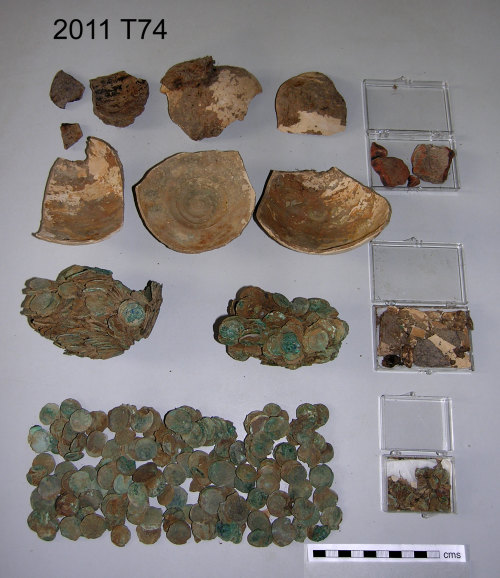
Coins and potsherds from the Brighstone Hoard
Wight, made sure that it ended up in a public collection by waving his right to a reward for the find. Brading Roman Villa is the lucky recipient of the hoard.
The coin hoard seems to have been deposited in the later 3rd Century AD. One of the coins was of a type not held by the British Museum, which adds to the academic interest of the find. Other of the coins are in poor condition and not legible, but it is fortunate that they are in a public collection nonetheless, where they can contribute to the overall context of the find. The hoard should make for an interesting and impressive display, if Brading Roman Villa are able to facilitate this.
06/04/2013
Things have been very quiet on the Piercebridge front recently, as I’ve been grappling with a chapter on the function of coinage in Roman Britain and more than 2600 coins from Old Winteringham in Lincolnshire!
However, things will soon get back on track with regards to Piercebridge as I’m off to Copenhagen tomorrow to give a lecture at the Roman Military Equipment conference. Entitled ‘Is the Piercebridge assemblage a military votive deposit?’, I’m hoping the paper will lead to lots of interesting discussion and hopefully, I’ll get identifications for some of the objects which have proved difficult to pin down.
Anyway, here’s the abstract for my lecture:
Is the Piercebridge assemblage a military votive deposit?
Over the past twenty years, an assemblage of approximately 4,000 Roman objects has been recovered from the bed of the River Tees at Piercebridge, County Durham. The assemblages includes a diverse range of material from jewellery to military artefacts, coinage to medical instruments. Although found directly adjacent to a late third century Roman fort and small town, these objects do not appear to represent settlement detritrus. Rather, they form a large and votive deposit, unparalleled even by the Sacred Spring at Bath and Coventina’s Well in Northumberland. This paper will provide an update on current work on the assemblage and assess the contribution that it will make to our understanding of Roman Piercebridge and of religious practice at the periphery of the Roman Empire. I will concentrate particularly on the role of the military equipment found within the assemblage. Can this equipment be interpreted as representing the offerings of soldiers passing through Piercebridge on their way to the northern frontier or could there be more complex meanings behind the selection and deposition of the material?
I will report back in a couple of weeks time!
05/31/2013
Here are two more recent finds reported under the Treasure Act which were able to be acquired by museums after the finders and landowners kindly waived their right to a reward.
Roman silver brooch
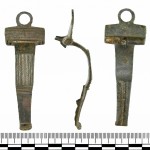
This beautiful brooch frame (2012 T640; GLO-734991) was found in September 2012 in Chedworth, Gloucestershire. You can still make out the fine dot decoration on the top of the body. We are very lucky that the finder, Mr Finch, and the landowner, Mr Axford, decided to forego their rewards in order that the brooch could go in to the collection of the award-winning Corinium Museum in Cirencester for all to enjoy.
Anglo-Saxon gold pendant
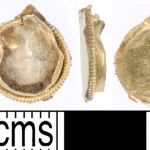
This little jewellery item (2012 T163; KENT-604B63) has sadly suffered a bit of damage over the course of the millenium it spent in the ground, but it is still easy to appreciate how beautiful it would have appeared when originally worn in the 7th Century. It is a fairly common example of its type, but it certainly would have belonged to someone with resources! Found in Sturry, Kent, the landowner, who wishes to remain anonymous, and the finder, Mr Hogwood, graciously decided to waive their rewards, allowing Canterbury Heritage Museum to acquire the pendant at no expense.
05/09/2013
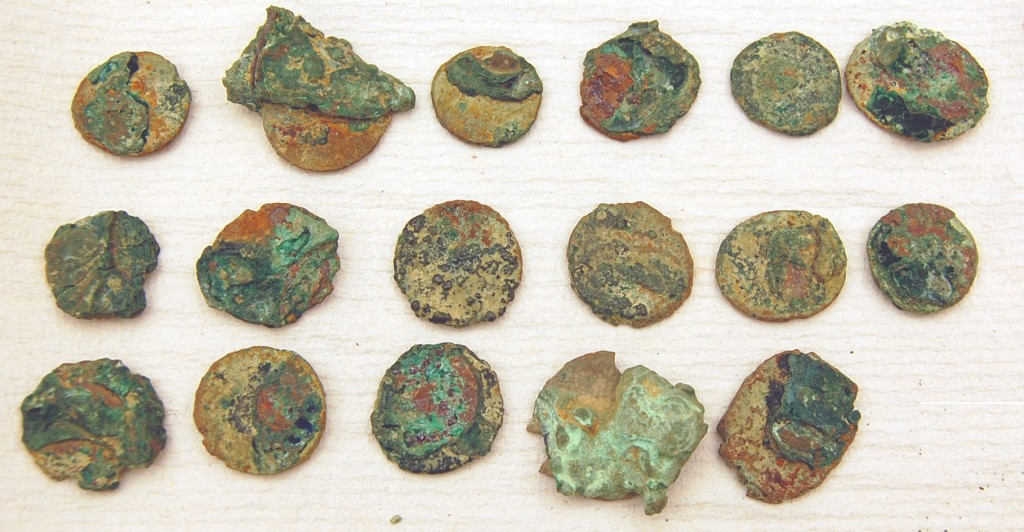
To reveal important surface information (as described in the previous blog post), the coins have to be cleaned of surface dirt and corrosion products. This is done using a combination of two treatments; chemical and mechanical cleaning.
The photograph above demonstrates a typical example of the Frome coins once they have had an initial rinse in tap water and brush to remove surface dirt. The majority of coins in this photograph are covered in corrosion products rendering them illegible. These coins would first be treated chemically to reduce the majority of the corrosion products.
Chemical Cleaning
Two different chemical treatments are employed to clean the coins depending on the extent and type of corrosion present. After an initial visual assessment the conservator they will make a decision as to which chemical treatment is required. This is usually a treatment consisting of either a low percentage of formic acid, or an Alkaline solution, or both.
Chemical cleaning allows for large batches of coins to be cleaned at once, which is critical when cleaning such a large hoard. The conservator carefully monitors changes in the coins appearance and condition during chemical cleaning to ensure that the coins are not ‘over cleaned’. All coins which have been chemically cleaned are thoroughly rinsed with water to remove any traces of chemicals.
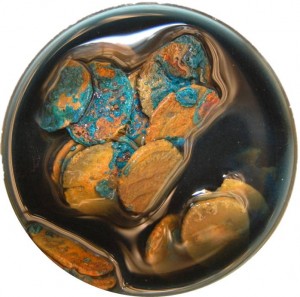
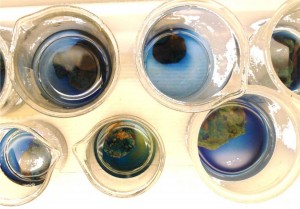
Coins in Alkaline Rochelle solution. This helps to reduce the level of blue/green copper carbonates.
Mechanical Cleaning
Mechanical cleaning is required when coins have small patches of corrosion obscuring important details. Coins with low levels of corrosion may not need chemical treatment, but will most likely require some mechanical cleaning. All coins which have been chemically cleaned require some form of mechanical cleaning.
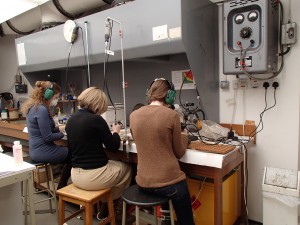
Production line of Dremel rotary brushing.
Mechanical cleaning involves reducing corrosion products with a scalpel under magnification and brushing to remove surface corrosion product residue. The photo above shows a production line of conservators using natural fibre dental brushes, on rotary Dremels® . This allows for a greater quantity of coins to be brushed at one time, and is more efficient than brushing them by hand.
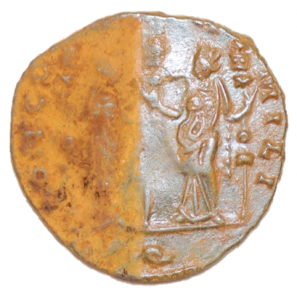
Following chemical cleaning corrosion and dirt residues remain on the coin. This coin has been brushed on one half to demonstrate the difference in legibility before and after.
05/03/2013
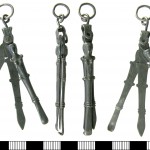
Toilet implement set from the Thames Foreshore
A find from the mud… Mudlark John Higginbotham discovered this interesting Post-Medieval silver toilet implement (LON-F6F381) on the foreshore of the River Thames. The individual elements of the tool, which could have been used in various aspects of personal hygiene and the application of cosmetics, overlap with one another to form a three-dimensional female figure. There are not many exact parallels recorded, although examples of the individual elements are known. The preservation of this complete set makes it all the more interesting.
Only those people with a license from the Port of London Authority (PLA) are allowed to search with metal detectors on the Thames foreshore and to disturb the ground. All others should restrict their activities to searching with their eyes alone!
John and the owner of the foreshore, the Crown Estate, agreed to waive their right to a reward for this item so that it could be placed in the Tower of London at no expense. Thank you both!
**Silver cuff link showcasing a royal occasion
**This single silver cuff link (SUSS-5904A7) was found by Tyndall Jones in Warningcamp, West Sussex. It would have originally been joined by a metal link to a matching cuff link which would have enabled them to hold together two pieces of fabric. Cuff links with this design ‘Crown over two hearts’ are likely to be associated with a commemoration of the marriage of Charles II to Catharine of Braganza in 1662.
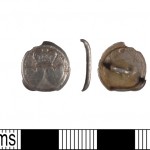
Silver cufflink from Warningcamp, West Sussex
You may have seen the Portable Antiquities Scheme’s Dr Michael Lewis talking about a similar cufflink in the collection of the British Museum on the ITV series Britain’s Secret Treasures. Michael has been researching these items and has noted that finders have reported almost 90 cuff links of this type since the start of the Treasure Act in 1997. Before then, there weren’t any records of these items at all!
Both Tyndall and the owner of the land, Nigel Draffan, waived their right to a reward for this piece of Treasure in order that it could be acquired by the nearby Littlehampton Museum. Many thanks Tyndall and Nigel!
05/03/2013
An Early Medieval silver-gilt disc brooch, now in the care of the Isle of Wight Heritage Service. Both the finder and landowners waived their right to a reward in this case IOW-A33D42
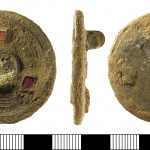
An Early Medieval silver-gilt disc brooch, now in the care of the Isle of Wight Heritage Service. Both the finder and landowners waived their right to a reward in this case (ref. IOW-A33D42)
Finds reported under the Treasure Act and recorded with the Portable Antiquities Scheme are occasionally acquired by museums at reduced or no cost, thanks to the generosity of finders and landowners. It is fitting to highlight these finds and to thank those individuals who have foregone a financial reward in order to see the finds in a museum collection where they can be studied and enjoyed by all. Each year, almost 10% of finds reported as potential Treasure are donated to museums, which is a great statistic. We’ll be trying to keep this blog updated periodically with recent donations as they are made.
How are donations made?
Finds which meet the criteria for ‘Treasure’ under the Treasure Act may be claimed by the Crown and placed in an appropriate museum. That museum is required to pay a reward to the finder and landowner equal to the market value of the find, but the finder and landowner can elect to waive their reward, thus enabling the museum to acquire the find without resorting to public expense. We refer to these acts as ‘donations’.
Most of the finds recorded with the Portable Antiquities Scheme are not Treasure, but a museum may nonetheless be interested in acquiring them. A Finds Liaison Officer or National Finds Advisor may recognise an item’s significance and speak to a museum curator about the item; if the museum curator wishes to acquire the find, they can be put in touch with the finder/landowner. The finder/landowner may then choose to donate the find to the museum if they wish.
Private collections
Many finders have built up their collections of archaeological finds over the years, and it is worth thinking about a long-term home for this material when the owner passes on. Museums may be willing to accept the material as a donation and it is advisable to discuss this possibility when the opportunity arises – before it’s too late!
Questions?
If you have any questions about donations, or if you are considering donating your find, speak to your local Finds Liaison Officer or the Treasure Team at the British Museum (treasure@britishmuseum.org).









